 W
WThe Action of 6 November 1794 was a naval engagement during the French Revolutionary Wars. Two British ships of the line, HMS Alexander and HMS Canada were intercepted while returning to Britain through the Celtic Sea by a large French squadron. The French squadron had sailed from Brest in search of an inward bound British convoy in October, but instead encountered the two British ships returning from escorting an outward-bound convoy. There had been no warning of the French approach as the British force assigned to watch Brest was absent at Plymouth due to the policy of operating a distant blockade.
 W
WThe Action of 7 May 1794 was a minor naval action fought between a British ship of the line and a French frigate early in the French Revolutionary Wars. The French Navy sought to disrupt British trade by intercepting and capturing merchant ships with roving frigates, a strategy countered by protecting British convoys with heavier warships, particularly in European waters. On 5 May 1794, the British escorts of a convoy from Cork sighted two French ships approaching and gave chase. The ships, a frigate and a corvette, outmatched by their opponents, separated and the convoy escorts did likewise, each following one of the raiders on a separate course.
 W
WMartin's cruise of 1794 was the only significant French naval operation of the year in the Mediterranean Sea. In 1793 France had gone to war with Great Britain and a wide coalition of European enemies in the French Revolutionary Wars. Early in the conflict the British had seized the French Mediterranean Fleet and their home port of Toulon, the town enduring a four month siege by French Republican forces in which the fleet was badly damaged. With the town and fleet back in French hands, the French set about effecting repairs as the British attacked the island of Corsica.
 W
WThe Action of 21 October 1794 was a minor naval engagement between Great Britain and France fought off the Breton coast of France during the second year of the French Revolutionary Wars. French frigates had been raiding British Atlantic trade routes with considerable success since the outbreak of the war, and in response the Admiralty had formed a frigate squadron to patrol the French Channel and Atlantic coasts in search of French raiders. On 13 October 1794, the large, modern and powerful 40-gun French frigate Révolutionnaire under the command of Captain Antoine René Thévenard sailed from Le Havre for a raiding cruise against British trade routes in the Atlantic. Eight days later, while rounding the Breton headland of Ushant about 25–30 nautical miles (56 km) out to sea, Révolutionnaire encountered the British frigate squadron, commanded by Commodore Sir Edward Pellew, which had secured a number of victories over French raiding frigates during the previous two years.
 W
WThe Action of 23 April 1794 took place between a British squadron of five frigates under the command of Sir John Borlase Warren and three frigates and a corvette under the command of Chef d'escadre F. Desgarceaux during the French Revolutionary Wars. Three of the French ships were captured.
 W
WThe frigate action of 29 May 1794—not to be confused with the much larger fleet action of 29 May 1794 that took place in the same waters at the same time—was a minor naval engagement of the French Revolutionary Wars between a Royal Navy frigate and a French Navy frigate. The action formed a minor part of the Atlantic campaign of May 1794, a campaign which culminated in the battle of the Glorious First of June, and was unusual in that the French ship Castor had only been in French hands for a few days at the time of the engagement. Castor had previously been a British ship, seized on 19 May by a French battle squadron in the Bay of Biscay and converted to French service while still at sea. While the main fleets manoeuvered around one another, Castor was detached in pursuit of a Dutch merchant ship and on 29 May encountered the smaller independently cruising British frigate HMS Carysfort.
 W
WThe Atlantic campaign of May 1794 was a series of operations conducted by the British Royal Navy's Channel Fleet against the French Navy's Atlantic Fleet, with the aim of preventing the passage of a strategically important French grain convoy travelling from the United States to France. The campaign involved commerce raiding by detached forces and two minor engagements, eventually culminating in the full fleet action of the Glorious First of June 1794, at which both fleets were badly mauled and both Britain and France claimed victory. The French lost seven battleships; the British none, but the battle distracted the British fleet long enough for the French convoy to safely reach port.
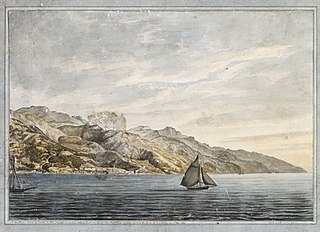 W
WThe Siege of Bastia was a combined British and Corsican military operation during the early stages of the French Revolutionary Wars. The Corsican people had risen up against the French garrison of the island in 1793, and sought support from the British Royal Navy's Mediterranean Fleet under Lord Hood. After initial delays in the autumn, Hood had supplied a small expeditionary force which had successfully driven the French out of the port of San Fiorenzo in February 1794. Hood then turned his attention to the nearby town of Bastia, which was held by a large French garrison.
 W
WThe Battle of Fallen Timbers was the final battle of the Northwest Indian War, a struggle between Native American tribes affiliated with the Western Confederacy and their British allies, against the nascent United States for control of the Northwest Territory. The battle took place amid trees toppled by a tornado near the Maumee River in northwestern Ohio at the site of the present-day city of Maumee, Ohio.
 W
WThe Battle of the Baztan Valley was fought between 23 July and 1 August 1794 during the French Revolutionary War, between a French force from the Army of the Western Pyrenees commanded by Bon-Adrien Jeannot de Moncey and the Spanish forces led by Don Ventura Caro. The French army drove the Spanish from their defenses, then followed the valley northward to the Atlantic coast. The Spanish forces holding the coastal defenses were compelled to surrender or flee.
 W
WThe Battle of the Black Mountain was fought from 17 to 20 November 1794 between the army of the First French Republic and the allied armies of the Kingdom of Spain and the Kingdom of Portugal. The French, led by Jacques François Dugommier defeated the Allies, who were commanded by Luis Firmín de Carvajal, Conde de la Unión. Though the Spanish right wing held, its left flank was driven back on the first day's fighting. On the last day of the battle, the French overran a key position and put the Spanish army to rout. The battle was remarkable in that both army commanders were slain. A Spanish artillery shell killed Dugommier early in the battle and Dominique Catherine de Pérignon assumed command of the French army. De la Union was shot dead while leading a cavalry charge on the last day of the fighting and was temporarily replaced by Jerónimo Girón-Moctezuma, Marquis de las Amarilas. The French victory led to the capture of Figueres and the Siege of Roses (Rosas), a port in Catalonia.
 W
WThe Second Battle of Boulou was a battle in the War of the Pyrenees, part of the French Revolutionary Wars. This battle saw the French Army of the Eastern Pyrenees led by Jacques François Dugommier attacking the joint Spanish-Portuguese Army of Catalonia under Luis Firmín de Carvajal, Conde de la Unión. Dugommier's decisive victory resulted in the French regaining nearly all the land they lost to the Kingdom of Spain in 1793. Le Boulou is on the modern A9 highway, 20 kilometres (12 mi) south of the department capital at Perpignan and 7 kilometres (4 mi) north of Le Perthus on the France-Spain border.
 W
WThe Battle of Boxtel was fought in the Duchy of Brabant on 14–15 September 1794, during the War of the First Coalition. It was part of the Flanders Campaign of 1793–94 in which British, Dutch and Austrian troops had attempted to launch an invasion of France through Flanders. It is often remembered as being the debut action of Arthur Wellesley, who later became the 1st Duke of Wellington.
 W
WThe Siege of Calvi was a combined British and Corsican military operation during the Invasion of Corsica in the early stages of the French Revolutionary Wars. The Corsican people had risen up against the French garrison of the island in 1793, and sought support from the British Royal Navy's Mediterranean Fleet under Lord Hood. Hood's fleet was delayed by the Siege of Toulon, but in February 1794 supplied a small expeditionary force which successfully defeated the French garrison of San Fiorenzo and then a larger force which besieged the town of Bastia. The British force, now led by General Charles Stuart, then turned their attention to the fortress of Calvi, the only remaining French-held fortress in Corsica.
 W
WThe Siege of Collioure saw a Republican French army led by Jacques François Dugommier invest a French port held by a Spanish garrison commanded by Eugenio Navarro. The actual siege work was carried out by Pierre François Sauret's reinforced division. After the three-and-a-half-week War of the Pyrenees siege the Spanish fleet sent to evacuate the garrison was blown off station by a storm. Navarro surrendered the town on the promise to exchange the paroled garrison with an equal number of French prisoners. After the defenders were released, the Spanish army commander Luis Firmín de Carvajal, Conde de la Unión refused to authorize the agreement or return any French captives. The infuriated French government afterward passed a decree ordering death to all Spanish prisoners and some units carried out the brutal order.
 W
WThe invasion of Corsica was a campaign fought in the spring and summer of 1794 by combined British military and Corsican irregular forces against a French garrison, early in the French Revolutionary Wars. The campaign centred on sieges of three principal towns in Northern Corsica; San Fiorenzo, Bastia and Calvi, which were in turn surrounded, besieged and bombarded until by August 1794 French forces had been driven from the island entirely.
 W
WThe 2nd Battle of Courtrai occurred during the War of the First Coalition near Kortrijk, Belgium, located about 85 kilometres (53 mi) west of Brussels.
 W
WThe Battle of Dego took place in present-day Italy during the War of the First Coalition between French and Austrian armies on 21 September 1794. It resulted in a French victory. The battle was described in Napoleon's correspondence, he having been present.
 W
WThe East Indies theatre of the French Revolutionary Wars was a series of campaigns related to the major European conflict known as the French Revolutionary Wars, fought between 1793 and 1801 between the new French Republic and its allies and a shifting alliance of rival powers. Although the Indian Ocean was separated by vast distance from the principal theatre of the conflict in Western Europe, it played a significant role due to the economic importance of the region to Great Britain, France's most constant opponent, of its colonies in India and the Far Eastern trade.
 W
WThe Battle of Erquelinnes or Battle of Péchant was part of the Flanders Campaign during the War of the First Coalition, and saw a Republican French army jointly led by Jacques Desjardin and Louis Charbonnier try to defend a bridgehead on the north bank of the Sambre River against a combined Habsburg Austrian and Dutch army led by Franz Wenzel, Graf von Kaunitz-Rietberg. The French crossed the Sambre on the 20th and held their positions for a few days. On the 24th Kaunitz launched an early-morning surprise attack that routed the French. The War of the First Coalition combat represented the second of five French attempts to gain a foothold on the north bank of the Sambre. Erquelinnes is a village in Belgium directly on the border with France. It is situated about 30 kilometres (19 mi) southwest of Charleroi.
 W
WThe Battle of Fleurus, on 26 June 1794, was an engagement between the army of the First French Republic, under General Jean-Baptiste Jourdan, and the Coalition Army, commanded by Prince Josias of Coburg, in the most significant battle of the Flanders Campaign in the Low Countries during the French Revolutionary Wars. Both sides had forces in the area of around 80,000 men but the French were able to concentrate their troops and defeat the First Coalition. The Allied defeat led to the permanent loss of the Austrian Netherlands and to the destruction of the Dutch Republic. The battle marked a turning point for the French army, which remained ascendant for the rest of the War of the First Coalition. The French use of the reconnaissance balloon l'Entreprenant was the first military use of an aircraft that influenced the result of a battle.
 W
WThe French Revolutionary Wars continued from 1793 with few immediate changes in the diplomatic situation as France fought the First coalition.
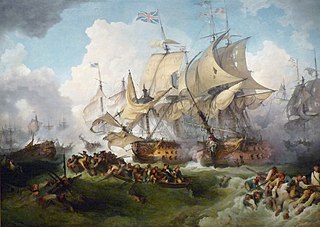 W
WThe Glorious First of June, also known as the Fourth Battle of Ushant or, in France, as the Bataille du 13 prairial an 2 or Combat de Prairial) of 1794 was the first and largest fleet action of the naval conflict between the Kingdom of Great Britain and the First French Republic during the French Revolutionary Wars.
 W
WThe Battle of Gosselies or Battle of Charleroi saw a Republican French army co-commanded by Jacques Desjardin and Louis Charbonnier try to cross the Sambre River against a joint Dutch and Habsburg Austrian army under William, Hereditary Prince of Orange. The French defeat in the battle marked the third of five attempts by their armies to win a foothold on the north bank of the Sambre during the War of the First Coalition. In 1794, Gosselies was a separate village but is now part of the Charleroi municipality, about 7 kilometres (4 mi) north of the city center. Charleroi is located about 60 kilometres (37 mi) south of Brussels.
 W
WThe Croisière du Grand Hiver was a French attempt to organise a winter naval campaign in the wake of the Glorious First of June.
 W
WThe Battle of Grandreng or Battle of Rouvroi saw a Republican French army jointly commanded by Louis Charbonnier and Jacques Desjardin attempt to advance across the Sambre River against a combined Habsburg Austrian and Dutch army under Franz Wenzel, Graf von Kaunitz-Rietberg. After winning crossings over the Sambre at Thuin and Lobbes on the 10th and Merbes-le-Château on the 12th, the French were defeated on 13 May at Grand-Reng and forced to retreat. The War of the First Coalition engagement marked the first of five attempts by the French armies to establish themselves on the north bank of the Sambre. Grand-Reng is now part of the village of Erquelinnes, Belgium, lying close to the border with France. Rouveroy (Rouvroi) is situated 3.8 kilometres (2.4 mi) north. Grand-Reng is located about 33 kilometres (21 mi) southwest of Charleroi.
 W
WThe Battle of Île Ronde was a minor naval engagement between small French Navy and British Royal Navy squadrons off Île de France, now named Mauritius, in the early stages of the French Revolutionary Wars. The battle was fought over control of the waters around Île de France, which was under blockade from the British squadron as French warships and privateers operating from the island posed a significant threat to vital British trade routes connected to British India and China.
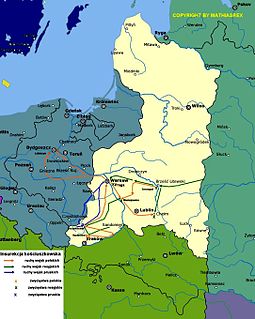 W
WThe Kościuszko Uprising was an uprising against the Russian Empire and the Kingdom of Prussia led by Tadeusz Kościuszko in the Polish–Lithuanian Commonwealth and the Prussian partition in 1794. It was a failed attempt to liberate the Polish–Lithuanian Commonwealth from Russian influence after the Second Partition of Poland (1793) and the creation of the Targowica Confederation.
 W
WThe siege of Luxembourg was a siege by France of the Habsburg-held Fortress of Luxembourg that lasted from 1794 until 7 June 1795, during the French Revolutionary Wars. Although the French army failed to breach the walls of the city, which were renowned as amongst the best in the world, the fortress was forced to surrender after more than seven months.
 W
WMartin's cruise of 1794 was the only significant French naval operation of the year in the Mediterranean Sea. In 1793 France had gone to war with Great Britain and a wide coalition of European enemies in the French Revolutionary Wars. Early in the conflict the British had seized the French Mediterranean Fleet and their home port of Toulon, the town enduring a four month siege by French Republican forces in which the fleet was badly damaged. With the town and fleet back in French hands, the French set about effecting repairs as the British attacked the island of Corsica.
 W
WThe Battle of Martinique was a successful 1.5 month British invasion from 5 February to 24 March 1794 of the French-held island of Martinique in the West Indies, during the French Revolutionary Wars.
 W
WThe Mediterranean campaign of 1793–1796 was a major theater of conflict in the early years of the French Revolutionary Wars. Fought during the War of the First Coalition, the campaign was primarily contested in the Western Mediterranean between the French Navy's Mediterranean Fleet, based at Toulon in Southern France, and the British Royal Navy's Mediterranean Fleet, supported by the Spanish Navy and the smaller navies of several Italian states. Major fighting was concentrated in the Ligurian Sea, and focused on British maintenance of and French resistance to a British close blockade of the French Mediterranean coast. Additional conflict spread along Mediterranean trade routes, contested by individual warships and small squadrons.
 W
WThe Battle of Mouscron was a series of clashes that occurred when the Republican French Army of the North under Jean-Charles Pichegru moved northeast to attack Menen (Menin) and was opposed by Coalition forces under the overall leadership of François Sébastien Charles Joseph de Croix, Count of Clerfayt. In their initial advance, the French began the Siege of Menin and captured Kortrijk (Courtrai). With Habsburg Austrian reinforcements, Clerfayt counterattacked on the 28th but Joseph Souham soon massed superior French forces and drove the Coalition troops out of the area. This Flanders Campaign action happened during the War of the First Coalition, part of the French Revolutionary Wars. The battle occurred near Mouscron, Belgium, located at the French border 9 kilometres (6 mi) south of Kortrijk and at Menen, located 11 kilometres (7 mi) west of Kortrijk.
 W
WThe Battle of Mykonos was a minor naval engagement fought in the main harbour of the Cycladic island of Mykonos on 17 June 1794 during the French Revolutionary Wars. A British Royal Navy squadron led by fourth rate ship HMS Romney was escorting a convoy of eight merchant ships westwards through the Aegean Sea to Smyrna when the French frigate Sibylle was sighted at anchor in the harbour of Mykonos town with three French merchant ships. Ordering the convoy to continue with the rest of the squadron, Captain William Paget diverted the 50-gun Romney to the port and demanded the surrender of the 40-gun French ship and its convoy.
 W
WThe Siege of Nijmegen occurred from 27 October to 8 November 1794 during the Flanders campaign of the War of the First Coalition. It was the last major military confrontation between the forces of the Revolutionary French First Republic and the reactionary First Coalition of European monarchs including William V, Prince of Orange, before the fall of the Dutch Republic in January 1795, which William had ruled as hereditary stadtholder since 1751. As commander-in-chief of the Dutch States Army, his indecision, several changes of mind and lack of coordination with his Anglo-Hanoverian, Hessian, Prussian and Austrian allies contributed to the eventual surrender of Nijmegen to the French revolutionaries.
 W
WThe Battle of Orbaizeta was fought from 15 to 17 October 1794 during the War of the Pyrenees, between the French Army of the western Pyrenees led by Bon-Adrien Jeannot de Moncey and Spanish forces under the command of Pedro Téllez-Girón, 9th Duke of Osuna. Part of the wider French Revolutionary Wars, this engagement was fought over a wide area to the northwest and northeast of Pamplona in Navarre and ended in a French victory. The Spanish defenders gave up territory to the north of Pamplona, including a number of strategic locations.
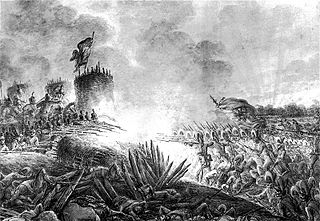 W
WThe Battle of Praga or the Second Battle of Warsaw of 1794 was a Russian assault on Praga, the easternmost suburb of Warsaw, during the Kościuszko Uprising in 1794. It was followed by a massacre of the civilian population of Praga.
 W
WThe recorded history of Seychelles dates back to the fourth of the Portuguese India Armadas led by Vasco da Gama, though it was likely already known to Arab navigators and other sailors for many centuries. On 15 March 1503, the scrivener Thomé Lopes noted the sighting of an elevated island, doubtless one the granitic islands and almost certainly Silhouette Island. The first recorded landing was by the men of the English East India Company ship Ascension, which arrived in Seychelles in January 1609. The islands were claimed by France in 1756. Seychelles remained uninhabited until the first settlers arrived on board the ship Thélemaque, which arrived on 27 August 1770. Captain Leblanc Lecore landed the first colonists, comprising 15 white men, eight Africans and five Indians. The Seychellois Creole language developed as a means of communication between the different races. The British frigate Orpheus commanded by Captain Henry Newcome arrived at Mahé on 16 May 1794. Terms of capitulation were drawn up and the next day Seychelles was surrendered to Britain. Following the fall of Mauritius to British forces, Captain Phillip Beaver of the Nisus arrived at Mahé on 23 April 1811 and took possession of Seychelles as a permanent colony of Britain. The Seychelles became an independent republic in 1976. Following a coup d'état, a socialist one-party state ruled the country from 1977 to 1993. The subsequent democratic Presidential elections were won by candidates of the same party.
 W
WThe Siege of Roses began on 28 November 1794 and lasted until 4 February 1795 when the Spanish garrison abandoned the port and the forces of the First French Republic took control. Dominique Catherine de Pérignon commanded the French army and Domingo Salvator Izquierdo led the Spanish defenders. The siege took place during the War of the Pyrenees which was part of the French Revolutionary Wars. The war ended in July 1795 and Roses was soon restored to Spain. Roses is a coastal city in northeastern Spain, located 43 kilometres (27 mi) northeast of Girona, Catalonia.
 W
WThe Siege of San Fiorenzo was a British military operation, supported by Corsican partisans early in the French Revolutionary Wars against the French-held town of San Fiorenzo on the Mediterranean island of Corsica. The Corsican people had risen up against the French Republican garrison in 1793 after an attempt to arrest the Corsican leader Pasquale Paoli during the Reign of Terror. The French had then been driven into three fortified towns on the northern coast; San Fiorenzo, Calvi, and Bastia and Paoli appealed to the British Royal Navy's Mediterranean Fleet, commanded by Lord Hood, for assistance against the French garrison.
 W
WThe Battle of Saorgio was fought from 24 to 28 April 1794 between a French First Republic army commanded by Pierre Jadart Dumerbion and the armies of the Kingdom of Sardinia-Piedmont and the Habsburg Monarchy led by Joseph Nikolaus De Vins. It was part of a successful French offensive designed to capture strategic positions in the Maritime Alps and Ligurian Alps, and on the Mediterranean coast. Tactical control of the battle was exercised by André Masséna for the French and Michelangelo Alessandro Colli-Marchi for the Coalition. Saorge is located in France, about 70 kilometres (43 mi) northeast of Nice. At the time of the battle, the town was named Saorgio and belonged to Piedmont.
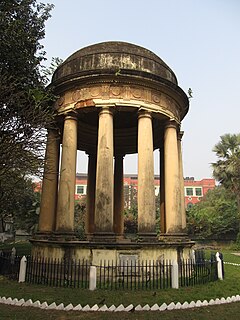 W
WThe Second Rohilla War was a conflict between British India and the Rohillas of Rampur in 1794.John Shore was governor general during the second Rohilla war.
 W
WThe Siege of Warsaw of 1794 was a joint Russian and Prussian siege of the capital of the Polish-Lithuanian Commonwealth, during the Kościuszko Uprising in the summer of 1794. It ended with the Polish victory when, after a two-month siege, the Prussian and Russian army ended the siege and withdrew from Warsaw.
 W
WThe Battle of Sprimont, Battle of Esneux or Battle of the Ourthe was a battle between French Republican and Austrian troops on the plateau between the valleys of the Vesdre, the Ourthe and the Amblève, 20 kilometres (12 mi) south of Liège. It occurred on 17 and 18 September 1794 and was a French Republican victory. The battle put a final end to the Ancien Régime in what is now Belgium, then essentially the Austrian Netherlands, Principality of Liège and the Principality of Stavelot-Malmedy. French troops dislodged Austrian troops occupying the plateau, though the French suffered heavy losses. Associated with the battle are the villages of Sprimont, Esneux, Fontin and the site of the La Redoute, whose name originates in a redoubt involved in the battle.
 W
WThe Sunda Strait campaign of January 1794 was a series of manoeuvres and naval actions fought between warships and privateers of the French Republic and a squadron of vessels sent by the British East India Company to protect trade in the region, later augmented by Dutch warships. The campaign developed as French forces based on Île de France reacted more quickly than the British forces in the Indian Ocean to the expansion of the French Revolutionary Wars on 1 February 1793. French privateers rapidly spread along the British trade routes in the Far East, becoming concentrated around the narrow Sunda Strait between the islands of Java and Sumatra in the Dutch East Indies. These ships were soon joined by French Navy frigates and began to inflict losses on shipping in the region. The Royal Navy forces in the Indian Ocean were deployed elsewhere and so the East India Company, the private enterprise that ruled much of British India in the 1790s and maintained their own fleet and navy, raised a squadron of armed merchant ships to patrol the Strait and drive off the raiders.
 W
WThe Battle of Tourcoing saw a Republican French army directed by General Joseph Souham defend against an attack by an Habsburg, British, and Hanoverian Coalition army under Austrian Prince Josias of Saxe-Coburg-Saalfeld and Prince Frederick, Duke of York and Albany. The French army was temporarily led by Souham in the absence of its normal commander Jean-Charles Pichegru. Threatened with encirclement, Souham and division commanders Jean Victor Marie Moreau and Jacques Philippe Bonnaud improvised a counterattack which defeated the Coalition's widely separated and badly coordinated columns. The War of the First Coalition action was fought near the town of Tourcoing, just north of Lille in northeastern France.
 W
WThe Battle of Tournay (1794) or Tournai was fought on 22 May 1794 as part of the Flanders Campaign in the Belgian province of Hainaut on the Schelde River between French forces under General Pichegru and Coalition forces under Prince Josias of Coburg, in which the Coalition forces were victorious.
 W
WThe Tripolitanian civil war was a conflict from 1793 to 1795 which occurred in what is today the country of Libya. Ali Benghul, an Ottoman officer, deposed Hamet Karamanli, the ruler of Tripolitania, who had ruled since the end of the corrupt and ineffective rule of Ali I in 1793. Hamet and his brother Yusuf returned to Tripoli with the aid of the Bey of Tunis and took control of the throne.
 W
WThe Whiskey Rebellion was a tax protest in the United States beginning in 1791 and ending in 1794 during the presidency of George Washington, ultimately under the command of American Revolutionary war veteran Major James McFarlane. The so-called "whiskey tax" was the first tax imposed on a domestic product by the newly formed federal government. Beer was difficult to transport and spoiled more easily than rum and whiskey. Rum distillation in the United States had been disrupted during the American War of Independence, and, for factors described below, whiskey distribution and consumption increased after the Revolutionary War. The "whiskey tax" became law in 1791, and was intended to generate revenue for the war debt incurred during the Revolutionary War. The tax applied to all distilled spirits, but consumption of American whiskey was rapidly expanding in the late 18th century, so the excise became widely known as a "whiskey tax". Farmers of the western frontier were accustomed to distilling their surplus rye, barley, wheat, corn, or fermented grain mixtures to make whiskey. These farmers resisted the tax. In these regions, whiskey often served as a medium of exchange. Many of the resisters were war veterans who believed that they were fighting for the principles of the American Revolution, in particular against taxation without local representation, while the federal government maintained that the taxes were the legal expression of Congressional taxation powers.
 W
WThe Siege of Ypres saw a Republican French army commanded by Jean-Charles Pichegru invest the fortress of Ypres and its 7,000-man garrison composed of Habsburg Austrians under Paul von Salis and Hessians led by Heinrich von Borcke and Georg von Lengerke. French troops under Joseph Souham fended off three relief attempts by the corps of François Sébastien Charles Joseph de Croix, Count of Clerfayt. Meanwhile, the French besiegers led by Jean Victor Marie Moreau compelled the Coalition defenders to surrender the city. The fighting occurred during the War of the First Coalition, part of the Wars of the French Revolution. In 1794 Ypres was part of the Austrian Netherlands, but today it is a municipality in Belgium, located about 120 kilometres (75 mi) west of Brussels.